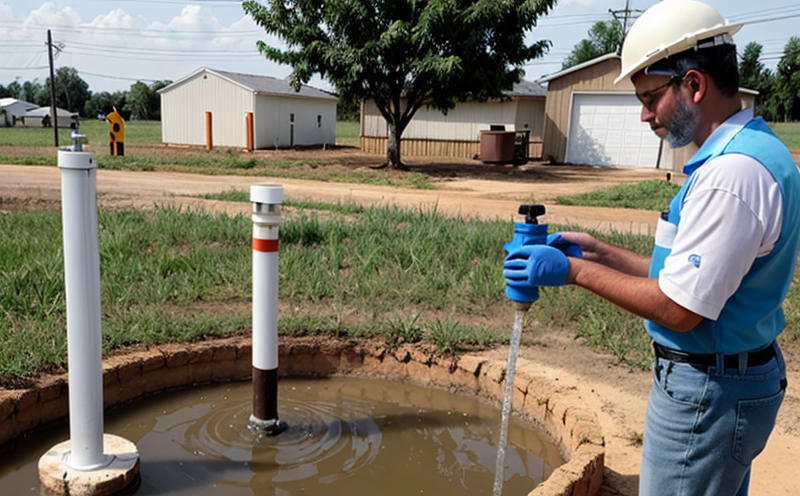ASTM D8283 Endocrine Disruptors Testing in Groundwater
The testing of groundwater for endocrine disruptors (EDs) is a critical process to ensure the safety and quality of water resources. The ASTM standard ASTM D8283 provides robust methodologies for detecting EDs in groundwater, which are substances that can interfere with the body’s endocrine system leading to adverse health effects.
The growing awareness of environmental impacts from industrial activities has led to stringent regulations aimed at mitigating these risks. Groundwater serves as a vital resource for drinking water and agricultural irrigation; hence, monitoring its quality is paramount. This service ensures compliance with regulatory standards such as those set by the U.S. Environmental Protection Agency (EPA) and other international bodies.
ASTM D8283 outlines procedures to identify estrogenic, anti-androgenic, and thyroid-disrupting compounds that might be present in groundwater samples. The test focuses on specific classes of compounds including alkylphenols, phthalates, bisphenol A (BPA), and nonylphenols among others. These chemicals are common by-products from various industrial processes and can contaminate groundwaters through improper disposal or runoff.
The methodology involves several steps starting with sample collection at designated locations representative of the area being tested. Properly collected samples must be preserved under controlled conditions until analysis begins. After preservation, laboratory techniques such as liquid chromatography-tandem mass spectrometry (LC-MS/MS) are used for precise quantification and identification.
Once analyzed, results provide quantitative data on the concentration levels of suspected EDs present in each sample. Compliance officers and quality managers rely heavily on these findings to make informed decisions about potential risks posed by contaminated groundwaters. For R&D engineers involved in developing safer products or processes, this testing helps them understand how their activities may affect local water bodies.
Accurate identification of EDs through ASTM D8283 ensures that appropriate measures can be taken to reduce contamination sources and protect public health. Compliance with such standards also plays a crucial role in maintaining trust between industries and regulatory agencies, fostering better relationships and stronger partnerships.
Scope and Methodology
The scope of ASTM D8283 covers the determination of endocrine-disrupting compounds (EDCs) in groundwater by liquid chromatography-tandem mass spectrometry (LC-MS/MS). This method aims to detect and quantify specific classes of EDCs that have been linked to adverse effects on human health and aquatic ecosystems.
The methodology begins with the collection of groundwater samples from predetermined wells or monitoring points. Samples should be collected following standard procedures outlined in ASTM D8283, ensuring they are free from contamination and representative of the area being tested. Once collected, these samples need to be stored properly until analysis can commence.
During sample preparation, preservatives may be added to prevent degradation of the analytes during storage. Additionally, filtration methods might be employed to remove particulate matter that could interfere with detection. After preparation, the samples undergo instrumental analysis using advanced analytical techniques such as LC-MS/MS.
The LC-MS/MS system operates by separating complex mixtures into individual components based on their physical properties like polarity and molecular weight before detecting them via mass spectrometry. This approach allows for highly sensitive detection of even trace amounts of EDCs within the sample matrix. Following analysis, quantitative results are generated indicating concentrations of various EDC classes.
Interpretation of these results involves comparing measured values against established reference levels or thresholds defined in relevant guidelines and regulations. Results help determine whether groundwater meets quality standards set forth by regulatory authorities like EPA or similar organizations worldwide.
International Acceptance and Recognition
The ASTM D8283 standard for endocrine disruptors testing in groundwater enjoys widespread recognition globally due to its rigorous scientific basis and comprehensive approach. Many countries have adopted this method as part of their national regulations aimed at protecting public health and environmental sustainability.
For instance, the European Union's Directive 91/676/EEC on water quality includes provisions for monitoring endocrine-disrupting chemicals in surface waters and groundwaters. While not explicitly specifying ASTM D8283, it aligns closely with its principles and objectives. Similarly, Canada’s National Pollutant Release Inventory (NPRI) requires reporting of certain EDCs based on analytical methods that could include those prescribed by ASTM.
Other nations like Australia and New Zealand have incorporated aspects of ASTM D8283 into their respective environmental policies. In South Africa, the Department of Water Affairs has recognized this standard for evaluating water quality in both urban and rural areas.
The acceptance of ASTM D8283 extends beyond regulatory frameworks to academic research communities too. Leading universities around the world utilize these guidelines when conducting studies on environmental contamination issues related to groundwater sources.
Moreover, international organizations such as the World Health Organization (WHO) recommend using similar methodologies for assessing potential risks associated with exposure to endocrine-disrupting compounds in drinking water supplies. By adhering to internationally accepted standards like ASTM D8283, laboratories ensure their work contributes positively towards global efforts aimed at safeguarding human health and preserving natural environments.
Use Cases and Application Examples
| Application Scenario | Description | ASTM D8283 Involvement | Outcome |
|---|---|---|---|
| Industrial Site Compliance Monitoring | A manufacturing plant discharges treated wastewater into a nearby aquifer. Regular groundwater monitoring using ASTM D8283 helps ensure compliance with discharge limits. | The standard is used to detect specific EDCs like BPA and phthalates in the groundwater around the site. | Results show no exceedance of regulatory thresholds, confirming proper treatment practices. |
| New Construction Project | A developer plans to construct a large residential complex near an existing industrial park. Pre-construction groundwater testing using ASTM D8283 identifies contamination risks before site development begins. | Testing focuses on identifying EDCs that could pose health hazards during construction and after occupancy. | Developer adjusts plans to include remediation measures, ensuring safer living conditions for residents. |
| Public Health Assessment | A local community suspects contamination of its primary drinking water supply. Authorities commission ASTM D8283 tests to assess the safety of the groundwater. | The standard helps pinpoint specific EDCs present and their concentrations, guiding further action if necessary. | No significant health risks found; reassures residents about the quality of their tap water. |





